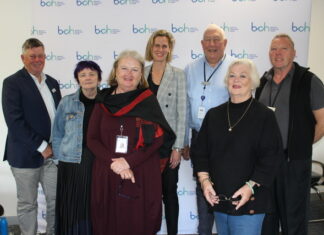Andrew Mathieson
STILL leading the march from the front, Margaret Dudley is the last of the remaining old guard of marching girls.
The rest of the Geelong procession has faded away like the fur on the trademark busby hats from another generation.
Marching is certainly not what it use to be – and the veteran of five decades couldn’t be any happier.
“I didn’t enjoy it back then,” she casts her mind back.
“I did it still, but I found it not challenging enough.
“Then as I grew and got into more of a dancing background, that’s when I had the love of music and movement in marching.”
The eldest of 12 children was pushed into marching as an eight-year-old because it was affordable.
Every one of the hundreds of routines since learned is still embedded in the back of her mind.
“As soon as my music comes on, it takes me back,” Maragaret says.
“Unfortunately, years ago the music had to be march music.”
Neat pleated skirts have made way over the years for outlandish array of leotards, glitter tops and, sometimes, even army gear fitted with combat boots.
The once innocent marching girl now resembles something shot out of a rock video clip with sounds to match.
While the face behind 57-year-old Margaret still looks young at heart, she can quickly recall the innocence from a bygone era.
“You once had to wear white boots, you had to wear the skirts and your knickers were checked,” she quips.
“People would laugh at this now, but you’d be marched up, you’d have chaperones there, you stand there disciplined, then your chaperone would say ‘lift’ and your bloomers were checked out.
“We had to have the right coloured briefs underneath and they had to be decent.”
Memories that come flooding back give the Highton mother-of-three adult girls a few chuckles and a little bit of a shudder.
Margaret is keen to break down the myths of marching for the public.
She quickly points out marching girls don’t trace behind a brass band or have a baton in hand.
“We were never baton twirlers in the first place – that is the ironical thing about it all,” she says.
More than just marching as the name suggests, regal precision drill and dance more accurately describes teams of perfectly choreographed performers.
The moves pushed the girls from second-rate and often muddy outdoor fields to more pristine indoor arenas.
“If anyone asks me to describe my sport, I say it’s precision dancing because a lot of other dancers will do what they do but not precisely,” Margaret believes.
“If people are expecting just to see girls walking around, just swinging their arms, then they are in for a great surprise.”
Marching had changed dramatically during the decade or so Margaret walked away to focus on aerobics instructing.
She was stunned on her return to be approached to enter the new world of cabaret marching with a male competitor.
“We made history,” she whispers.
“This young man, Barry Merrett, and myself, stepped out as the first male/female competitor ever in the sport of marching.”
The new freestyle approach allowed marching to branch out from the stuffy uniforms. Officials in Australia and New Zealand introduced solo and duo performances to give the sport more appeal.
So Margaret’s biggest thrill came from capturing the 1993 Australian solo title at just over 40, ahead of a couple of flexible teenagers.
That same year she also won a silver medal with her sister, Sharon, in the duo competition.
The bigger shock arrived two years earlier when a bronze at her first-ever national championships against the previous two solo winners left her in denial.
“When they read my name out, I froze,” Margaret tells.
“I said to the girl standing beside me, ‘did she say Margaret Dudley’ and the girl said, ‘yes’.
“They were beckoning me to come over and I stood there still believing they made an error.”
Get the latest news to your email inbox FREE!
REGISTER





